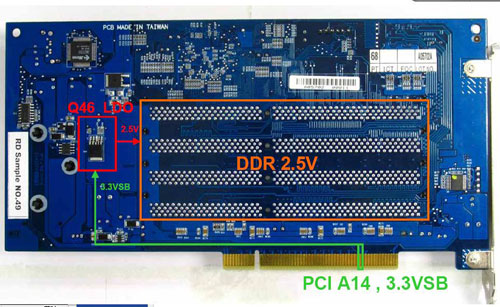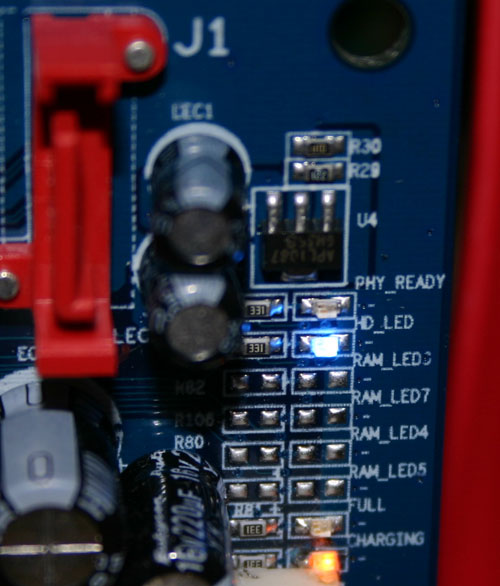Gigabyte's i-RAM: Affordable Solid State Storage
by Anand Lal Shimpi on July 25, 2005 3:50 PM EST- Posted in
- Storage
i-RAM's Limitations
Since your data is stored on a volatile medium with the i-RAM, a loss of power could mean that everything stored on the card would be erased with no hopes for recovery. While a lot of users may keep their computers on 24/7, there are always occasional power outages that would spell certain doom for i-RAM owners. In order to combat this possibility, Gigabyte outfitted the i-RAM with its own rechargeable battery pack.
There are only three conditions where the i-RAM runs off of battery power:
1) When the i-RAM is unplugged from the PCI slot;For whatever reason, unplugging the i-RAM from the PCI slot causes its power consumption to go up considerably, and will actually drain its battery a lot quicker than the specified 16 hours. We originally did this to test how long the i-RAM would last on battery power, but then were later told by Gigabyte not to do this because it puts the i-RAM in a state of accelerated battery consumption.
2) When the power cable is unplugged from your power supply (or the power supply is disconnected from your motherboard; and
3) When the power button on your power supply is turned off.
For the most part, the i-RAM will always be powered. Your data is only at risk if you have a long-term power outage or you physically remove the i-RAM card.
If you run out of battery power, you will lose all data and the i-RAM will stop appearing as a drive letter in Windows as soon as you power it back up. You'll have to re-create the partition data and copy/install all of your files and programs over again.
The card features four LEDs that indicate its status: PHY_READY, HD_LED, Full and Charging.











133 Comments
View All Comments
NStriker - Thursday, July 28, 2005 - link
Anand quotes $90 per GB of RAM here, but I'm wondering if the I-Ram works with the much cheaper high-density junk you see out there all the time. Like 128Mx4 modules. On motherboards, usually only SiS chipsets can handle that type of RAM, but there's no reason the Xilinx FPGA couldn't.Right now I'm seeing 1GB of that stuff for $63.
jonsin - Thursday, July 28, 2005 - link
Since Athlon64 north bridge no need the memory controller. Why shouldn't the original memory controller used for iRam purpose. By supporting both SDRam and DDR Ram, people can make use of their old RAM (which no longer useful nowadays) and make it as Physical Ram Drive.Spare some space for additional DDR module slot on motherboard exclusively for iRam, and additional daughter card can be added for even more Slots.
Would it be a cheaper solution for iRam ultimately ?
jonsin - Thursday, July 28, 2005 - link
And more, power can be directly drive from ATA power in motherboard. By implementing similar approach to iRam, an extra battery can power the ram for certain hours.By enabling north bridge to be DDR/SDRam capability is not a new technology, every chipset compnay have such tech. They can just stick the original memory controller with lower performance (DDR200, so more moudle can be supported and lower cost) to north bridge, the cost overhead is relatively small.
What I think the extra cost comes from extra motherboard layout, north bridge die size, chipset packaging cost (more pins). I suppose it can cost as low as $20 ?
jonsin - Thursday, July 28, 2005 - link
More, the original SATA physical link can be omitted as the controller in North Bridge can communicate directory to SATA controller internally (South bridge thru HT ?) In this case, would the performance increate considerably and the overall layout more tidy ? (no need external cable and cards)mindless1 - Friday, July 29, 2005 - link
NO these are all problems. The purpose is to have a universal platform support that is gentle on power consumption. That means a tailored controller and even then we're seeing the main limit is the battery. "Tidy" is an unimportant human desire, particularly less important inside a closed PC case. All they have to do is route bus traces well on the card and be done.slumbuk - Wednesday, July 27, 2005 - link
HP sell an add on for their DL 380 server for $200 (at discount) that gets you 128MB of disk write cache... makes a good system also fast for disk writes.This card could be used by linux vendors to enable file-system data and control logging for similar money for GB(s) of write cache... Cheap, reliable, fast general purpose file servers.. that have fast disk write speed without risking data loss.. Speed meaning no disk-head latency, no rotational latency - just transfer time.
It would sell better with ECC memory.. or the ability to use two cards in a mirror.. at least to careful server buyers..
slumbuk - Wednesday, July 27, 2005 - link
You could set up the iRam drive as the journal device for Resier or Ext-3 logged file systems - and log both control info and data - for fast, safe systems without too much fuss.I think I want one - but not as much as I want other stuff..
AtaStrumf - Wednesday, July 27, 2005 - link
Interesting but hardly useful for most. Kind of makes sense to only make 1000, but of course that's where the $150 price tag comes from.rbabiak - Wednesday, July 27, 2005 - link
i guess it would add to the base board cost, but a SATA controller on the PCI card would make it a littl nicer as then you are not takeing up one of your SATA channels, i only have 2 and they are current both used for a Raid-0Also if they made the PCI card a SATA interface and then short circeted the backend to conect directly to the memory, wouldn't they then be able to get much higher transfer speeds than sata and yet all the existint SATA divers could be used with it, given they emulate a existing SATA interface.
DerekWilson - Thursday, July 28, 2005 - link
Better to use the onboard ports ...a 33MHz/32bit PCI slot only grants a max of 133MB/sec. This would make the PCI bus a limiting factor to the SATA controller.
Step beyond that and remember that the PCI bus is shared among all your PCI cards. Depending on the motherboard some onboard devices can be built onto the PCI bus.
With bandwidth on current southbridge chips already being dedicated to SATA (or SATA-II), it would be a waste in more ways than one to build a SATA controller into the i-RAM.
That's my take on it anyway.
Derek Wilson